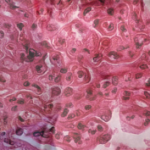Consideration of the case posed at the beginning of this article illustrates these points. Thus, the patient clearly had moderately severe proliferative LN. A reasonable option would be to use three pulses of IV-MP followed by either AZA, MMF, or IV-CY, although most people would perhaps choose MMF as initial treatment because of the better data supporting the use of MMF versus AZA in this setting, and the potential for ovarian toxicity of IV-CY. Should the patient fail to achieve complete remission after three to six months of AZA or MMF, then she could be switched to a combination of IV-MP with IV-CY with protection of her ovaries.
In actual practice, the patient we described remitted initially with MMF but developed a severe nephritic flare with increase of her creatinine while on MMF. She was rescued with IV-MP and IV-CY pulses and reached remission after seven monthly pulses. While on maintenance quarterly IV-CY pulses, she had another flare of her nephritis and was switched to rituximab and MMF. She achieved remission after the second cycle of rituximab. She has subsequently been in remission for more than five years on 1 g/day of MMF and low-dose, alternate-day prednisone. Meanwhile, she was married and was switched to AZA because of her desire to have a family.
As this case shows well, current treatment of lupus nephritis poses many challenges and demands flexibility and willingness to try various approaches using data from well-conducted studies as a guide. While much needs to be done, for the future, we are optimistic that additional trials of biologics will be successful. Until that time, immunosuppressive drugs are here to stay. Optimization of the existing therapies by incorporating them in the best possible strategy is clearly the way to go.
Drs. Boumpas and Bertsias both work in Internal Medicine and Rheumatology, Clinical Immunology and Allergy, at the University of Crete Medical School in Greece.
References
- Hahn BH, Kantor OS, Osterland CK. Azathioprine plus prednisone compared with prednisone alone in the treatment of systemic lupus erythematosus. Report of a prospective controlled trial in 24 patients. Ann Intern Med. 1975;83:597-605.
- Decker JL, Klippel JH, Plotz PH, Steinberg AD. Cyclophosphamide or azathioprine in lupus glomerulonephritis. A controlled trial: Results at 28 months. Ann Intern Med. 1975; 83:606-615.
- Grootscholten C, Ligtenberg G, Hagen EC, et al. Azathioprine/methylprednisolone versus cyclophosphamide in proliferative lupus nephritis. A randomized controlled trial. Kidney Int. 2006;70:732-742.
- Gourley MF, Austin HA, 3rd, Scott D, et al. Methylprednisolone and cyclophosphamide, alone or in combination, in patients with lupus nephritis. A randomized, controlled trial. Ann Intern Med. 1996;125:549-557.
- Illei GG, Austin HA, Crane M, et al. Combination therapy with pulse cyclophosphamide plus pulse methylprednisolone improves long-term renal outcome without adding toxicity in patients with lupus nephritis. Ann Intern Med. 2001;135:248-257.
- Houssiau FA, Vasconcelos C, D’Cruz D, et al. Immunosuppressive therapy in lupus nephritis: The Euro-Lupus Nephritis Trial, a randomized trial of low-dose versus high-dose intravenous cyclophosphamide. Arthritis Rheum. 2002; 46:2121-2131.
- Houssiau FA, Vasconcelos C, D’Cruz D, et al. The 10-year follow-up data of the Euro-Lupus Nephritis Trial comparing low-dose and high-dose intravenous cyclophosphamide. Ann Rheum Dis. 2010;69:61-64.
- Boumpas DT, Austin HA 3rd, Vaughn EM, et al. Controlled trial of pulse methylprednisolone versus two regimens of pulse cyclophosphamide in severe lupus nephritis. Lancet. 1992;340:741-745.
- Bertsias G, Boumpas DT. Update on the management of lupus nephritis: Let the treatment fit the patient. Nat Clin Pract Rheumatol. 2008;4:464-472.
- Bertsias GK, Salmon JE, Boumpas DT. Therapeutic opportunities in systemic lupus erythematosus: State of the art and prospects for the new decade. Ann Rheum Dis. 2010;69:1603-1611.
- Appel GB, Contreras G, Dooley MA, et al. Mycophenolate mofetil versus cyclophosphamide for induction treatment of lupus nephritis. J Am Soc Nephrol. 2009;20:1103-1112.
- Wofsy D, Appel GB, Dooley MA, et al. Aspreva Lupus Management Study maintenance results. Lupus. 2010;19:S27.
- Houssiau FA, D’Cruz D, Sangle S, et al. Azathioprine versus mycophenolate mofetil for long-term immunosuppression in lupus nephritis: Results from the MAINTAIN Nephritis Trial. Ann Rheum Dis. 2010;69:2083-2089.
- Boumpas DT, Bertsias GK, Balow JE. A decade of mycophenolate mofetil for lupus nephritis: Is the glass half-empty or half-full? Ann Rheum Dis. 2010;69:2059-2061.
